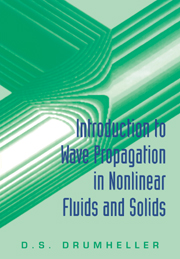Chapter 4 - Constitutive Models
Published online by Cambridge University Press: 05 June 2012
Summary
Throughout our development of mechanics and thermomechanics we have used constitutive models to describe waves in materials. In Chapter 2 we used the constitutive model for an elastic material to describe linear-elastic waves, structured waves, and shock discontinuities. However, we could not describe the steady wave with this constitutive model. In Chapter 3 we introduced more complex constitutive models for materials that dissipate work and conduct heat. We used the viscous material, the thermoviscous material, and the thermoelastic material to extend our description of nonlinear waves. These constitutive models are quite general descriptions that include gases, liquids, and solids. More specific constitutive models are discussed in this chapter. These models include the ideal gas and the Mie–Grüneisen solid. We also study plastic flow, porosity, and detonation.
We often calculate nonlinear wave phenomena with complex numerical computer codes. With such powerful capabilities you may be tempted to simply characterize the energy state of a material with large tables of data that yield values of equilibrium stress, temperature, stiffnesses, specifics heats, and thermal expansion coefficients for given values of F and η. Accurate computations of some very common materials rely heavily upon this method. The computation of nonlinear pressure waves in water is an important example. However, even with this capability, questions arise about the constitutive descriptions of these materials. For example, if water is heated by a shock wave, it often spontaneously “flashes” to steam when the pressure drops again in response to a release wave.
- Type
- Chapter
- Information
- Introduction to Wave Propagation in Nonlinear Fluids and Solids , pp. 321 - 474Publisher: Cambridge University PressPrint publication year: 1998



